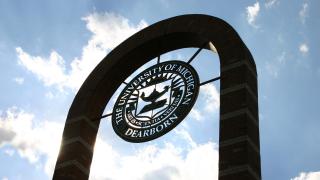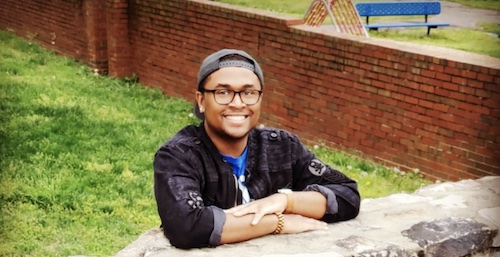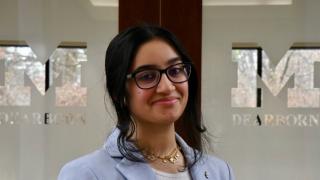Knowing the importance of connecting children to nature, the campus’ OMI team helped create new pathways for Detroit’s youth to connect with the environment in a variety of ways like field trips to the Environment Interpretive Center, job-shadowing opportunities, virtual Q&As with professionals, nature-centered programming ideas and more.
This collective impact collaborative network of over 50 regional organizations is called SouthEast Michigan Wild (SEMI Wild). Its vision? For all people, especially for marginalized communities, in the Detroit area to have access to nature, to promote ecosystem sustainability, and to learn about related educational and career opportunities.
“In the U.S., more than 80 percent of human beings live in urban centers and that number is projected to grow. There’s nothing wrong with living in a city. But it can disconnect us from nature. Our office has worked with many of these organizations for years, but we wanted to formalize the partnership and connect the dots to create a more structured pathway for our youth,” OMI Director Tracy Hall said. “This is about well-being. This is about education. This is about career building. Putting those together, this is about shaping the future of our urban communities.”
The concept for SEMI Wild began in 2015 when the OMI team worked with a few others to create a local network committed to environmental sustainability and collaboration. But as word grew, so did this network. It went from a small partnership of about a dozen organizations, then called Metro Detroit Nature Network, to a large diverse group of nonprofit, government, and advocacy organizations. OMI no longer provides the administrative support for the organization, as it now has elected leaders and an infrastructure. However, they continue to stay involved by co-chairing SEMI Wild’s Youth Pathways Committee.
Currently, there are 50-plus organizations in SEMI Wild that include the Detroit Zoological Society, the Michigan Department of Natural Resources, the U.S. Fish & Wildlife Service, Detroit Audubon, Ducks Unlimited and many more. Blake-Smith spent the past year compiling SEMI Wild resources, organization contacts, involvement opportunities and more.
A key part of the initiative is to connect underserved communities to nature because there’s a serious lack of diversity in green-focused groups and in environmental science careers.
This is a problem that needs to be corrected, OMI Assistant Director Molly Manley said. Especially when people of color are three times more likely to live in ‘nature deprived’ U.S. neighborhoods and Brown, Black and Indigenous populations are more likely to experience air and water pollution than white people and suffer the health impacts.
“Black and Brown people want change in their communities. They are experiencing environmental hazards and crises. But it’s hard to see yourself in a field when the people who are making the decisions don’t look like you,” Manley said.
Manley has worked with this initiative since its inception. She’s seen the power of young people finding job shadowing opportunities, speaking with conservation and environmental professionals, and beginning to see themselves working in careers where they can improve the environment and the connection their friends and family have with nature.
“When first thinking of conservation and nature and careers associated with it, some people get this thought of a forest ranger living in the middle of nowhere. Sure, you can be a forest ranger. But you can also develop and maintain city parks, conduct research that monitors the air and water quality, lead conservation and health advocacy efforts and more. The goal here is to show that there are careers here. And those positions impact the communities we live in.”
To help underrepresented youth and young adults better connect with nature, SEMI Wild has organized connections that help youth learn how to conduct research like monitoring the sediment in the Detroit River, see the importance of GIS Systems and mapping tools, and view themselves in careers where they can make decisions on how to better connect people who live in urban areas.
For example, to encourage interest in citizen science — public participation in science research — UM-Dearborn EIC Director and Social Sciences Lecturer Claudia Walters, along with UM-Dearborn students Audrey Taylor and Courtney Wagner, used an OMI Seed grant to create five Geographic Information System (GIS) tutorials that give young people a better understanding of mapping tools and potential applications. GIS is widely used in many environmental and place-making fields.
In addition to showing UM-Dearborn’s connections to a GIS education, interested youth can learn about other campus programs like biological sciences, urban and regional studies and environmental science. To make these programs accessible, the OMI team also shares scholarships and financial aid information like the Go Blue Guarantee.
Blake-Smith, whose one-year of Americorps campus service is soon coming to an end, has seen the impact of SEMI Wild in the Detroit area.
For the past year, strengthening the network’s youth work has been Blake-Smith’s focus. He, along with his OMI colleagues, spent time coaching interns at Belle Isle Nature Center, connecting youth-serving organizations such as Detroit Hispanic Development Corporation to the right opportunities for their populations, and has seen the energy, excitement and curiosity that only the outdoors — or a favorite tree — can bring.
If you are an organization interested in joining the SEMI Wild collective or want more information, which is free to join, email [email protected]. Media outlets interested in connecting with the Office of Metropolitan Impact about this initiative and others in the Southeast Michigan region can email [email protected].







